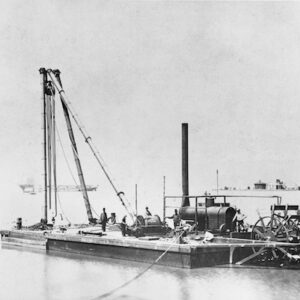Tag: Mare Island Naval Shipyard (Vallejo CA)
Wikipedia says: The Mare Island Naval Shipyard (MINSY or MINS) was the first United States Navy base established on the Pacific Ocean and was in service 142 years from 1854 to 1996.[5] It is located on Mare Island, 23 miles (37 km) northeast of San Francisco, in Vallejo, California. MINSY made a name for itself as the premier U.S. West Coast submarine port as well as serving as the controlling force in San Francisco Bay Area shipbuilding efforts during World War II.
The naval base was closed on 31 March 1996, with more than 7,500 civilians on its payroll, and has gone through several redevelopment phases. It was registered as a California Historical Landmark in 1960, and parts of it were declared a National Historic Landmark District in 1975.
Beginnings
In September 1849, Lieutenant Commander William Pope McArthur was placed in command of the US survey schooner Ewing, which had been brought around Cape Horn to the West Coast by Lieutenant Washington Allon Bartlett. Upon reaching San Francisco, Ewing and the other ship assigned to the survey, USS Massachusetts, were hampered from progress due to desertions of their crews to the gold fields, including a mutiny when crew members rowing into the city from Ewing threw an officer overboard in an attempt to desert. They managed to survey the Mare Island Strait before steaming to Hawaii to obtain crewmen from Hawaiian monarch King Kamehameha III. They returned to San Francisco in the spring of 1850 with the coastal survey of northern California beginning on 4 April 1850 and continued up to the mouth of the Columbia River. On 1 August 1850, while still in Oregon, McArthur purchased a 1⁄16 interest in Mare Island for $468.50 then returned to San Francisco later that month to prepare charts and write reports.
On 15 January 1852, Secretary of the Navy William A. Graham ordered a Naval Commission to select a site for a naval yard on the Pacific Coast. Commodore D. Sloat along with Commodore C. Ringgold, Simon F. Blunt and William P.S. Sanger (former overseer of construction of Drydock Number One, Norfolk Naval Shipyard) were appointed to the commission. On 13 July 1852, Sloat recommended Mare Island, across Mare Island Strait from the settlement of Vallejo. The next month, a sectional floating dry dock, authorized by Secretary Graham for use in California, arrived in San Francisco. It was built in New York and shipped in sections around Cape Horn. In 1853, the Navy purchased Mare Island, the original 956 acres (387 ha) of land for MINSY, for a grand sum of $83,491; subsequently the floating dry dock was moved into place in Mare Island Strait.: 31 McArthur’s family share (he had died a few months after purchasing his share of Mare Island) was $5,218. Based on observations at the site, Sanger conceived the original plan for the naval yard at Mare Island, later formalized by planners at the Navy Bureau of Yards and Docks in Washington, D.C. Although the 1854 Sanger plan was basically sound and mostly implemented, it did not overcome its natural shortcoming: the naval yard was built on an island on shallow San Pablo Bay.
On 16 September 1854, the Navy commenced shipbuilding and ship repair operations at Mare Island under the command of then-Commander David Farragut, who later gained fame during the U.S. Civil War Battle of Mobile Bay, when he gave the order, “Damn the torpedoes, full speed ahead!” Farragut and his newly appointed Civil Engineer, Daniel Turner, began to implement Sanger’s original plan with only a few minor modifications. Of the early buildings constructed under Turner, five are still standing in historic Shipyard North: Building 46, a smithery built in 1856; Building 71, a storage built in 1858; Building 85, a foundry built in 1858; Building 87, a machine shop built in 1858; and Building 89/91, a boiler shop built in 1858. The other MINSY area constructed was the Ammunition Depot at the south end of the Island, used to store ordnance from warships under repair. Still standing from the Turner years in Ammunition Depot is Building A1, a magazine built in 1857.
MINSY served as a major Pacific Ocean repair station during the late 19th century, handling American as well as Japanese and Russian vessels in the course of duty.
In 1861, the longest lived of the clipper ships, Syren, was brought to Mare Island Navy Yard for $15,000 of repairs. Syren had struck Mile Rock twice while trying to sail out of the Golden Gate.
Marines first arrived for duty in 1862 under the command of Maj Addison Garland, who was the first officer to command the Marine barracks on the island.
Built in 1901 under the guidance of Chaplain Adam A. McAlister and U.S. Senator George C. Perkins, St. Peter’s Chapel was the second chapel built on a U.S. Navy property, the first in the Pacific, and the first interdenominational chapel in the armed services. According to historian McDonald, “The chapel, more than any other building, bears witness to the closeness of the community that developed at the Mare Island Naval Shipyard.”
Mare Island Naval Shipyard also took a commanding role in civil defense and emergency response on the West Coast, dispatching warships to the Pacific Northwest to subdue Native American unrest. MINSY sent ships such as Wyoming south to Central America and the Panama Canal to protect US political and commercial interests. Some of the support, logistics and munition requirements for the Spanish–American War were filled by Mare Island. MINSY sent men, materiel and ships to San Francisco in response to the fires following the 1906 earthquake. Arctic rescue missions were mounted as necessary. Ordnance manufacturing and storage were two further key missions at MINSY for nearly all of its active service, including ordnance used prior to the American Civil War.






